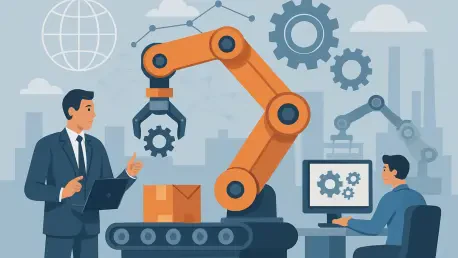Imagine a world where businesses, from small startups to global conglomerates, operate with unparalleled efficiency, driven by cutting-edge technologies managed not in-house but through strategic partnerships. The global automation outsourcing market is on a trajectory of explosive growth, with recent projections estimating a rise from $7.15 billion in 2024 to an astonishing $86.41 billion by 2034, propelled by a compound annual growth rate of 28.3%. This surge reflects a fundamental shift in how industries approach operational challenges, increasingly turning to third-party providers for solutions powered by artificial intelligence (AI) and robotic process automation (RPA). Such reliance on external expertise is not merely a trend but a transformative force, enabling companies to streamline processes, reduce costs, and focus on core competencies. As technology continues to evolve at a rapid pace, understanding the implications of this shift becomes crucial for industries aiming to remain competitive in an ever-changing landscape.
Regional Leadership and Technological Dominance
North America stands as the frontrunner in the automation outsourcing arena, commanding a 38.4% market share that translates to $2.74 billion in revenue, with the United States alone contributing $2.47 billion. This leadership is underpinned by a robust digital infrastructure and an early embrace of outsourced automation services, setting a benchmark for other regions. A significant factor in this dominance is the widespread use of rule-based RPA solutions, which account for 78.1% of the market due to their ability to handle repetitive tasks with minimal human intervention, thereby boosting labor efficiency. Large enterprises, with a 68.3% adoption rate, are particularly active in leveraging these technologies, utilizing their substantial resources to automate high-volume operations. This trend highlights a broader movement toward scalability and efficiency, where the integration of advanced tools through outsourcing partners allows businesses to adapt swiftly to market demands without the burden of developing complex systems internally.
Industry-Specific Impacts and Future Trajectories
The impact of automation outsourcing varies across sectors, with the banking, financial services, and insurance (BFSI) industry leading the charge by holding a 24.9% market share, driven by the need for precision in fraud detection, compliance, and customer service through AI and RPA. Meanwhile, the IT sector, with a commanding 32.5% share, relies heavily on outsourcing to enhance software development, testing, and system operations, ensuring agility in a fast-paced digital environment. A notable preference for integrated, end-to-end automation solutions, which capture 66.1% of the market, underscores the demand for comprehensive approaches that minimize errors and optimize processes. The rise of cloud-based technologies and AI-powered analytics further accelerates this evolution, offering faster deployment and continuous improvement. Looking back, it has become evident that these advancements laid a strong foundation for industries to remain agile. Moving forward, the focus should center on fostering global collaboration to expand access to these technologies, ensuring that even smaller markets can harness automation to drive innovation and growth.









